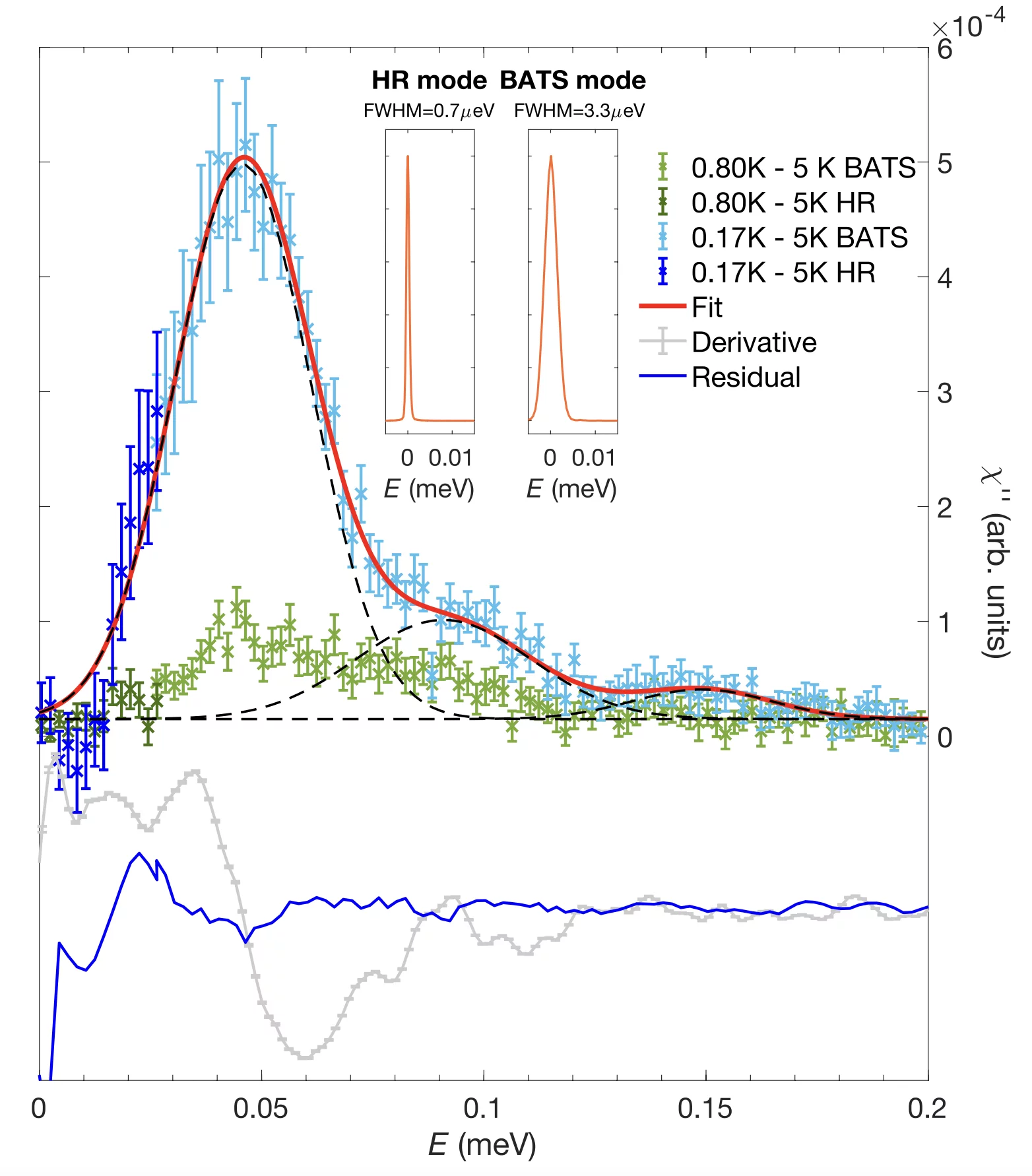Fractionalization – a phenomenon whereby quasiparticles that cannot be constructed as combinations of the elementary constituents emerge, is known as a beautiful manifestation of quantum mechanics. Now specific signatures of this physics have been observed in a three-dimensional system known as quantum spin ice.
Spin ices are crystalline materials with rather peculiar magnetic properties. The atoms in their lattices are arranged in geometries that resemble that of frozen water — hence the ‘ice’ in their name. Their electronic spins undergo a local constraint that prevents the formation of a single state of minimum energy. Instead, spin ices consist of a macroscopic number of degenerate configurations.
When such configurations are traversed by quantum fluctuations, totally new phenomena can emerge. These so-called 'quantum spin liquids' have long attracted substantial interest from theorists and experimentalists alike.
Instead of the simple ‘order parameter’ characterizing symmetry-breaking phases, the long-range quantum entangled nature of such states is described by an emergent dynamical ‘gauge field’ (Figure 1). Finding experimental signatures of this quantum organization is however very difficult.
As for many magnetic materials, neutron scattering is a very powerful tool to investigate quantum spin liquids. In general, neutrons are expected to create spin-flip excitations leading to integer changes of the total spin. In a quantum spin liquid, however, neutrons should generate pairs of fractional excitations each carrying spin ½ and known as ‘spinons’. Once created, these quasiparticles deconfine: they separate and execute quantum motion. This happens under the constraints of the emergent gauge field, so that their dynamics is highly nontrivial, therefore theorists have long struggled to predict the time-dependent response in detail.
An international collaboration led by Romain Sibille from the Laboratory for Neutron Scattering and Imaging at the Paul Scherrer Institute, Switzerland, has now managed to find experimental evidence of fractionalization in a candidate quantum spin ice material. As they report in Nature Physics this week [1], the team presents strong evidence that they have identified spectroscopic features of fractional spinon excitations in a cerium pyrochlore oxide (Ce2Sn2O7).
The story of Ce2Sn2O7 started in 2015 when the PSI team worked together with researchers at the Institut Néel, CNRS, Grenoble, to identify cerium pyrochlores as potential hosts for the quantum spin ice ground state [2]. In 2020, further progress was made to determine the nature of the correlations using the HRPT diffractometer at PSI, in collaboration with researchers from CEA, Saclay, and to get the first indications for the existence of fractional excitations in this material [3]. The latter was done using the IN5 Time-Of-Flight neutron spectrometer at the Institut Laue-Langevin. Although this experiment already pointed towards the general shape expected for fractional excitations – a continuum, the experimental resolution prevented to unveil its detailed features, like the energy gap. This is because magnetic interactions in rare-earth pyrochlore oxides are characterized by small energy scales, typically of the order of 0.01 to 0.1 meV.
Thanks to instrumental developments on the backscattering neutron spectrometer IN16B at the ILL [4,5], the team was able to obtain much higher resolution data over an extended window of energy transfers. Two complementary IN16B experiments using the ‘high-resolution’ configuration, and ‘time-of-flight’ option, provided a detailed view of the time dependent magnetic response. The first achievement realized by the backscattering data (Figure 2) is to demonstrate the gapped nature of the continuum, consistent with expectations for spinons in a quantum spin ice [6]. But this is not the only finding.
Indeed, the fine resolution of the data over a large range of energy transfers was instrumental in revealing an additional feature: the main peak centered on the energy of the dominant interaction in this material is accompanied by additional, weaker peaks at higher energy transfers. This asymmetry of the time dependent magnetic response was anticipated by a model published in 2019 [7]. More recent theory results [8] provided additional predictions, showing that the spectrum in the main phase of quantum spin ice is expected to have three peaks, with decreasing intensities at higher energies, whose relative positions are directly related to the ratio of interactions in the Hamiltonian. Teaming up with theoreticians from the University of Toronto, Canada, and Rice University, US, the team of experimentalists from PSI, CEA, CNRS and ILL further analyzed the data with the latest theory results at hands. The combination of extremely high resolution data and theory modelling allows to identify specific signatures of fractionalization in a three-dimensional quantum spin liquid. Remarkably, the spectrum directly relates to the ratio of exchange interactions that on one hand stabilize a spin ice manifold and on the other hand induce quantum fluctuations between these configurations.
Contact
Dr. Romain Sibille
Paul Scherrer Institut, 5232 Villigen PSI, Switzerland
Phone: +41 56 310 3580, e-mail: romain.sibille@psi.ch
References
Porée, V., Yan, H., Desrochers, F., Petit, S., Lhotel, E., Appel, M., Ollivier, J., Kim, Y.-B., Nevidomskyy, A. H. and Sibille, R. Evidence for fractional matter coupled to an emergent gauge field in a quantum spin ice. Nat. Phys. doi:10.1038/s41567-024-02711-w (2024).
(Free-to-view version: https://rdcu.be/d3i88)
- Sibille, R., Lhotel, E., Pomjakushin, V., Baines, C., Fennell, T. and Kenzelmann, M. Candidate quantum spin liquid in the Ce3+ pyrochlore stannate Ce2Sn2O7. Phys. Rev. Lett. 115, 097202 (2015).
- Sibille, R. et al. A quantum liquid of magnetic octupoles on the pyrochlore lattice. Nature Phys. 16, 546–552 (2020).
- Appel, M. & Frick, B. Note: one order of magnitude better signal-to-noise ratio for neutron backscattering. Rev. Sci. Instrum 88, 036105 (2017).
- Appel, M., Frick, B. & Magerl, A. A flexible high speed pulse chopper system for an inverted neutron time-of-flight option on backscattering spectrometers. Sci. Rep. 8, 13580 (2018).
- Morampudi, S. D., Wilczek, F. & Laumann, C. R. Spectroscopy of spinons in Coulomb quantum spin liquids. Phys. Rev. Lett. 124, 097204 (2020).
- Udagawa, M. & Moessner, R. Spectrum of itinerant fractional excitations in quantum spin ice. Phys. Rev. Lett. 122, 117201 (2019).
- Desrochers, F. & Kim, Y. B. Spectroscopic signatures of fractionalization in octupolar quantum spin ice. Phys. Rev. Lett. 132, 066502 (2024).
Additional reading
https://news.rice.edu/news/2024/researchers-uncover-strong-light-matter-interactions-quantum-spin-liquids
(Media release of Rice University, US)



